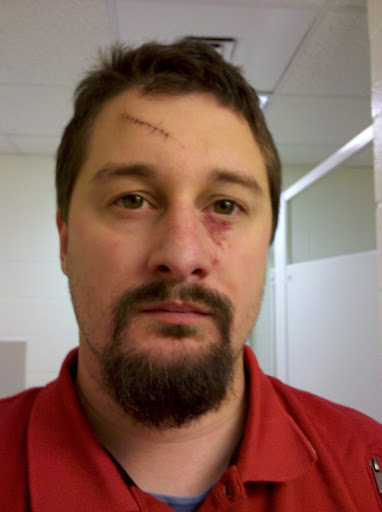 Humans, we are fragile creatures. We bend and break and tear. Lacking a rigid exoskeleton, dense armored plates, calcium carbonate shells, our skin becomes our first line of defense against a hostile, machete-filled world. Fortunately, while we do break, we can also heal ourselves through a wonderfully complex system of self-repair.
Humans, we are fragile creatures. We bend and break and tear. Lacking a rigid exoskeleton, dense armored plates, calcium carbonate shells, our skin becomes our first line of defense against a hostile, machete-filled world. Fortunately, while we do break, we can also heal ourselves through a wonderfully complex system of self-repair.
As stated earlier, this is not a medical blog and we have limited experience discussing medicine. For more detailed and experienced medical blogging, please check out two of my favorite medical blogs, Science-based Medicine and White Coat Underground. Over the next few weeks, I’ll be liveblogging my body’s own healing process as I recover from a machete blow to the head.
The physiology of wound healing and scar formation in the human body is a complicated and fascinating.

Wound healing, after a traumatic laceration, occurs in three phases spread out over several weeks: Inflammation, Proliferation, and Maturation.
Inflammation
Immediately after injury, blood begins to clot around the wound. The clot is formed by a complex matrix of blood platelets, fibrins, and other proteins that build up a barrier between the damaged tissue and the external environment. As this matrix hardens and becomes stiff, fibroblasts turn into powerful contractile cells and pull the edges of the wound together. During this phase, the immune system also has to deal with any bacterial infection introduced during the original trauma.
Proliferation
Several days after the initial injury, the coagulation cascade begins, with the fibrin clot serving as the foundation for tissue repair. Fibroblasts begin synthesizing new tissue components to replace the damaged ones. Simultaneously, degradation begins on the damaged tissue and the fibrin matrix to allow new tissue to develop. This fresh, provisional tissue is the scar tissue that will eventually be replaced.

Maturation
After enough provisional tissue has been produced, the body switches from repair to reconstruction. The last of the fibrin matrix is broken down, and the provisional scar tissue is replaced by more permanent tissue.
Scar formation is dependent on the length of the initial inflammation period, as well as the mechanical stresses imposed on the wound as it heals. Scarred area are almost always weaker than the surrounding skin, although the amount of tissue can make the area feel stiff or tight depending on how well it healed.
Speaking of healing, mine is healing nicely.
~Southern Fried Scientist
I remember coming across a poster diagraming the coagulation cascade in my first years as an undergrad. Blew my mind to realize how complex and detailed a process it was to make a scab.
I wanted to throw up a graph of the cascade, but it was so amazingly complex that I wasn’t prepared to explain it. Healing is awesome
To be fair, the coagulation cascade isn’t very complicated as far as cell signalling phenomena go. It also gets a lot simpler once you realize that most of the intermediates are essentially linear, so you can usually pretty much ignore them. Then again, I like cell signalling.
In any case, I’m glad it’s working for you!
you know me, once you turn genes into proteins I’m hopeless.